Dear Zazie, Here is today’s Lovers’ Chronicle from Mac Tag dedicated to his muse. Who holds your heart? Rhett
The Lovers’ Chronicle
Dear Muse,
© copyright 2020 mac tag/cowboy coleridge all rights reserved
© copyright 2019 mac tag/cowboy coleridge all rights reserved
“You have not said two words.”
i do not want to ruin it
“Sleep with me?”
absolutely
……
she taught me
how to let go
and what it meant
to miss someone
she was prone
to walk about
in her bare feet
she liked dressin’ up
and vodka and caviar
she would pour
and whisper,
“Sublime.”
and say,
“Savour it. And don’t eat it
all at once. Because that way,
there is nothing left to enjoy.”
we would stay up all night
talkin, dancin’, walkin’
deserted streets drinkin’
from a bottle of champagne
we met every night
in the same room
in that old hotel
until one night…
she taught me
somethin’
to believe in
© copyright 2018 mac tag/cowboy coleridge all rights reserved
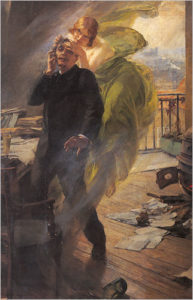
Albert Maignan’s Green Muse (1895): a poet succumbs to the Green Fairy.
what a week
sorry,
wine will not do
gotta chase
“la fée verte”
and hold
the sugar…
indeed, somethin’
akin to magic…
a worn copy
of Manon Lescaut
voices from the past
nights spent underneath
a High Plain’s sky
full of stars
long road trips
on two-lane blacktops
stoppin’ for first light
or last
writin’ verse or sketchin’
long gone memories
of when
© copyright 2017 mac tag/cowboy coleridge all rights reserved
Hold The Heart
Somethin’ akin to magic
Bein’ with a full woman
Who can hold the heart
Of an inamorato
Somethin’ happens
In seein’ the lightness
And swiftness of movement
Watchin’ her dance
Ridin’ horseback
Brushin’ her hair
In witnessin’ her
Fervent attentions
Her ardent advances
Somethin’ happens
Somethin’ happens
Bein’ with you
A woman who
has a crown
of enchantment
and can hold my heart
The Song of the Day is “Hold the Heart” by Big Country. we do not own any rights to this song. no copyright infringement intended
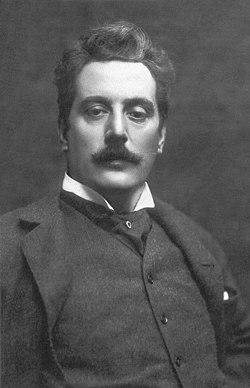
Today is the birthday of Giacomo Puccini Antonio Domenico Michele Secondo Maria Puccini (born Giacomo Antonio Domenico Michele Secondo Maria Puccini; Tuscany; 22 December 1858 – 29 November 1924); opera composer. In my opinion, the greatest composer of Italian opera after Verdi. Puccini’s early work was rooted in traditional late-19th-century romantic Italian opera. Later, he successfully developed his work in the realistic verismo style, of which he became one of the leading exponents. Puccini’s most renowned works are La bohème (1896), Tosca (1900), and Madama Butterfly (1904), all of which are among the important operas played as standards.
Manon Lescaut
Manon Lescaut premiered at the Teatro Regio in Turin on 2 February 1893. By coincidence, Puccini’s first enduringly popular opera appeared within a week of the premiere of Verdi’s last opera, Falstaff, which was first performed on 9 February 1893. In anticipation of the premiere, La Stampa wrote that Puccini was a young man concerning whom “great hopes” had a real basis (“un giovane che e tra i pochi sul quale le larghe speranze non siano benigne illusioni“). Manon Lescaut was Puccini’s first triumph, acclaimed by critics and public alike. After the London premiere in 1894, George Bernard Shaw pronounced: “Puccini looks to me more like the heir of Verdi than any of his rivals.”

La bohème
Puccini’s next work after Manon Lescaut was La bohème, a four-act opera based on the 1851 book by Henri Murger, La Vie de Bohème. La bohème premiered in Turin in 1896, conducted by Arturo Toscanini. Within a few years, it had been performed throughout many of the leading opera houses of Europe, including Britain, as well as in the United States. It was a popular success, and remains one of the most frequently performed operas ever written.
The libretto of the opera, freely adapted from Murger’s episodic novel combines comic elements of the impoverished life of the young protagonists with the tragic aspects, such as the death of the young seamstress Mimí. Puccini’s own life as young man in Milan served as a source of inspiration for elements of the libretto. During his years as a conservatory student and in the years before Manon Lescaut, he experienced poverty similar to that of the bohemians in La bohème, including chronic shortage of necessities like food, clothing and money to pay rent. Puccini himself commented: “I lived that Bohème, when there wasn’t yet any thought stirring in my brain of seeking the theme of an opera”. (“Quella Bohème io l’ho vissuta, quando ancora non mi mulinava nel cervello l’idea di cercarvi l’argomento per un’opera in musica.“)
Tosca
Puccini’s next work after La bohème was Tosca (1900), arguably Puccini’s first foray into verismo, the realistic depiction of many facets of real life including violence. Puccini had been considering an opera on this theme since he saw the play Tosca by Victorien Sardou in 1889, when he wrote to his publisher, Giulio Ricordi, begging him to get Sardou’s permission for the work to be made into an opera: “I see in this Tosca the opera I need, with no overblown proportions, no elaborate spectacle, nor will it call for the usual excessive amount of music.”

Madama Butterfly
The original version of Madama Butterfly, premiered at La Scala on 17 February 1904 with Rosina Storchio in the title role. It was initially greeted with great hostility. When Storchio’s kimono accidentally lifted during the performance, some in the audience started shouting: “The butterfly is pregnant” and “There is the little Toscanini”. The latter comment referred to her well publicised affair with Arturo Toscanini. This version was in two acts; after its disastrous premiere, Puccini withdrew the opera, revising it for what was virtually a second premiere at Brescia in May 1904 and performances in Buenos Aires, London, the USA and Paris. In 1907, Puccini made his final revisions to the opera in a fifth version, which has become known as the “standard version”.

Turandot
Turandot, Puccini’s final opera, was left unfinished, and the last two scenes were completed by Franco Alfano based on the composer’s sketches. The libretto for Turandot was based on a play of the same name by Carlo Gozzi. The music of the opera is heavily inflected with pentatonic motifs, intended to produce an Asiatic flavor to the music. Turandot contains a number of memorable stand-alone arias, among them Nessun dorma.
In the autumn of 1884, Puccini began a relationship with a married woman named Elvira Gemignani (née Bonturi, 1860–1930) in Lucca. Elvira’s husband, Narciso Gemignani, was a philanderer, and Elvira’s marriage was not a happy one. Elvira became pregnant by Puccini. Elvira left Lucca when the pregnancy began to show, and gave birth elsewhere to avoid gossip. Elvira, Antonio and Elvira’s daughter by Narciso, began to live with Puccini shortly afterwards. Narciso was killed by the husband of a woman that Narciso had an affair with, dying on 26 February 1903. Only then, in early 1904, were Puccini and Elvira able to marry.
The marriage between Puccini and Elvira was also troubled by infidelity, as Puccini had frequent affairs himself, including with well-known singers such as Maria Jeritza, Emmy Destinn, Cesira Ferrani, and Hariclea Darclée.
In 1909, Elvira publicly accused Doria Manfredi, a maid working for the Puccini family, of having an affair with the composer. Following the accusation, Doria Manfredi committed suicide. An autopsy determined, however, that Doria had died a virgin, refuting the allegations. Elvira was prosecuted for slander, and was sentenced to more than five months in prison, although a payment to the Manfredi family by Puccini spared Elvira from having to serve the sentence. Puccini may have been having an affair with Giulia Manfredi, Doria’s cousin.
A chain smoker of Toscano cigars and cigarettes, Puccini began to complain of chronic sore throats towards the end of 1923. A diagnosis of throat cancer led his doctors to recommend a new and experimental radiation therapy treatment, which was being offered in Brussels. Puccini and his wife never knew how serious the cancer was, as the news was revealed only to his son.
Puccini died in Brussels on 29 November 1924, from complications after the treatment; uncontrolled bleeding led to a heart attack the day after surgery. News of his death reached Rome during a performance of La bohème. The opera was immediately stopped, and the orchestra played Chopin’s Funeral March for the stunned audience. He was buried in Milan, in Toscanini’s family tomb, as a temporary measure. In 1926 his son arranged for the transfer of his father’s remains to a specially created chapel inside the Puccini villa at Torre del Lago.

Today is the birthday of Kenneth Charles Marion Rexroth (December 22, 1905 – June 6, 1982); poet, translator and critical essayist. He is regarded as a central figure in the San Francisco Renaissance. Although he did not consider himself to be a Beat poet, and disliked the association, he was dubbed the “Father of the Beats” by Time Magazine. He was among the first poets in the United States to explore traditional Japanese poetic forms such as haiku.
Rexroth viewed love for another person as a sacramental act that could connect one with a transcendent, universal awareness. In his introduction to his poem The Phoenix and the Tortoise, Rexroth articulated his understanding of love and marriage: “The process as I see it goes something like this: from abandon to erotic mysticism, from erotic mysticism to the ethical mysticism of sacramental marriage, thence to the realization of the ethical mysticism of universal responsibility.”
Rexroth married Andrée Dutcher in 1927, a commercial artist and painter from Chicago. He claimed to have fallen in love with her at first sight when he saw her in the doorway of the apartment building he was renting. He encouraged Dutcher to pursue non-commercial painting, and she gave him feedback on his writing. The two shared many interests and what Rexroth described as a perfect relationship. Their marriage deteriorated, however, and the couple was divorced near Rexroth’s 35th birthday. Andrée died of complications from epilepsy shortly after, in 1940. Her death triggered sadness in Rexroth, who wrote a number of elegiac poems in her honor.
Within a year of Andrée’s death, Rexroth married the nurse and poet Marie Kass. They opened up their home to weekly literary discussions, anti-war protesters, and Japanese-American convalescents avoiding internment. The two separated in 1948.
In 1949, Rexroth traveled to Europe with Marthe Larsen. The two were married in Aix-en-Provence despite Rexroth still being legally married to Marie. When the couple returned to the USA, Marthe was pregnant. In 1956, Marthe fell in love with the poet, Robert Creeley, and she later left Kenneth despite his pleas for her to stay. Rexroth later removed all instances of her name from his poetry.
After living in San Francisco for 41 years, Rexroth moved to Santa Barbara in 1968. After a few years, he married Carol Tinker, his longtime assistant. They remained married until Rexroth’s death in 1982.
Verse
In Defense of the Earth (1956)[edit]
- The holiness of the real
Is always there, accessible
In total immanence. The nodes
Of transcendence coagulate
In you, the experiencer,
And in the other, the lover.- “Time Is the Mercy of Eternity” – The title of this poem is derived from a line by William Blake : “Time is the mercy of Eternity; without Time’s swiftness Which is the swiftest of all things, all were eternal torment.”)
- “Time Is the Mercy of Eternity” – The title of this poem is derived from a line by William Blake : “Time is the mercy of Eternity; without Time’s swiftness Which is the swiftest of all things, all were eternal torment.”)
- All night I lay awake beside you,
Leaning on my elbow, watching your
Sleeping face, that face whose purity
Never ceases to astonish me.
- Towards the end of the night, as trucks rumbled
In the streets, you stirred, cuddled to me,
And spoke my name. Your voice was the voice
Of a girl who had never known loss
Of love, betrayal, mistrust, or lie.
- Now I know surely and forever,
However much I have blotted our
Waking love, its memory is still
there. And I know the web, the net,
The blind and crippled bird. For then, for
One brief instant it was not blind, nor
Trapped, not crippled. For one heart beat the
Heart was free and moved itself. O love,
I who am lost and damned with words,
Whose words are a business and an art,
I have no words. These words, this poem, this
Is all confusion and ignorance.
But I know that coached by your sweet heart,
My heart beat one free beat and sent
Through all my flesh the blood of truth.
The Great Nebula of Andromeda
- In the star-filled dark we cook
Our macaroni and eat
By lantern light. Stars cluster
Around our table like fireflies.
- Late at night the horses stumble
Around the camp and I awake.
I lie on my elbow watching
Your beautiful sleeping face
Like a jewel in the moonlight.
If you are lucky and the
Nations let you, you will live
Far into the twenty-first
Century. I pick up the glass
And watch the Great Nebula
Of Andromeda swim like
A phosphorescent amoeba
Slowly around the Pole. Far
Away in distant cities
Fat-hearted men are planning
To murder you while you sleep.
And today is the birthday of Jean-Michel Basquiat (December 22, 1960 – August 12, 1988); artist who rose to success during the 1980s as part of the Neo-expressionism movement.
Gallery
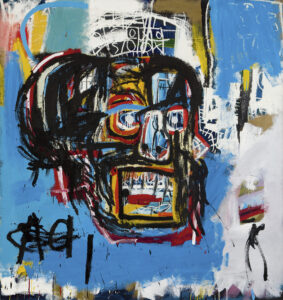
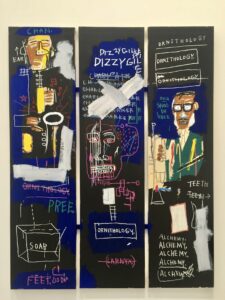
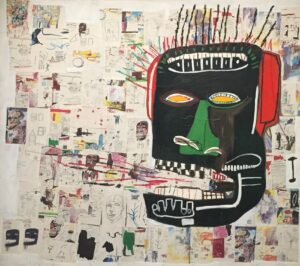
Mac Tag

No Comments on "The Lovers’ Chronicle 22 December – somethin’ – birth of Puccini – verse by Kenneth Rexroth – art by Jean-Michel Basquiat"